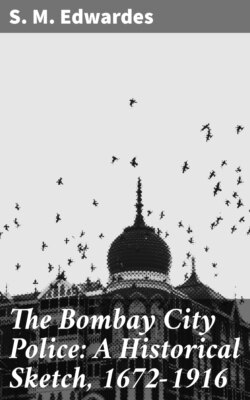The Bombay City Police: A Historical Sketch, 1672-1916

Реклама. ООО «ЛитРес», ИНН: 7719571260.
Оглавление
S. M. Edwardes. The Bombay City Police: A Historical Sketch, 1672-1916
The Bombay City Police: A Historical Sketch, 1672-1916
Table of Contents
PREFACE
ILLUSTRATIONS
THE BOMBAY CITY POLICE. A HISTORICAL SKETCH. 1672-1916
CHAPTER I. The Bhandari Militia. 1672-1800
CHAPTER II. The Rise of the Magistracy. 1800-1855
CHAPTER III. Mr. Charles Forjett. 1855-1863
CHAPTER IV. Sir Frank Souter Kt., C.S.I. 1864-1888
CHAPTER V. Lieut.-Colonel W. H. Wilson. 1888-1893
CHAPTER VI. Mr. R. H. Vincent, C.I.E. 1893-1898
CHAPTER VII. Mr. Hartley Kennedy, C.S.I. 1899-1901
CHAPTER VIII. Mr. H. G. Gell, M.V.O. 1902-1909
CHAPTER IX. Mr. S. M. Edwardes, C.S.I., C.V.O. 1909-1916
APPENDIX. Mr. Edwardes’ Report on the final Moharram Riot of 1911 and the Bombay Government’s order thereon
Footnote
INDEX
Отрывок из книги
S. M. Edwardes
Published by Good Press, 2021
.....
Notwithstanding these arrangements, the volume of crime showed no diminution. Murder, robbery and theft were still of frequent occurrence outside the Fort walls: and in the vain hope of imposing some check upon the lawless element, the Bombay Government in August, 1776, ordered parties of regular sepoys to be added to the Bhandari patrols. Three years later, in February, 1779, they decided, apparently as an experiment, to supplant the Bhandari militia entirely by patrols of sepoys, which were to be furnished by “the battalion of sepoy marines”. These patrols were to scour the woods nightly, accompanied by “a peace officer”, who was to report every morning to the acting magistrate.[21] Still there was no improvement, and the dissatisfaction of the general public was forcibly expressed at the close of 1778 or early in the following year by the grand Jury, which demanded a thorough reform of the police.[22] In the course of their presentment they stated that “the frequent robberies and the difficulties attending the detection of aggressors, called loudly for some establishment clothed with such authority as should effectually protect the innocent and bring the guilty to trial”, and they proposed that His Majesty’s Justices should apply to Government for the appointment of an officer with ample authority to effect the end in view.[23]
This pronouncement of the Grand Jury was the precursor of the first appointment of an executive Chief of Police in Bombay. On February 17, 1779, Mr. James Tod (or Todd) was appointed “Lieutenant of Police”, on probation, with an allowance of Rs. 4 per diem, and on March 3rd of that year he was sworn into office; a formal commission signed by Mr. William Hornby, the Governor, was granted to him, and a public notification of the creation of the office and of the powers vested in it was issued. He was also furnished with copies of the regulations in force, and was required by the terms of his commission to follow all orders given to him by the Government or by the Justices of the Peace.[24]
.....